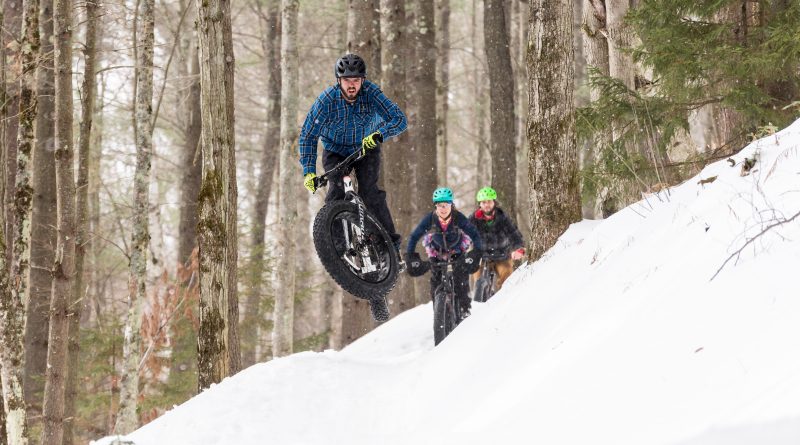Pro Tips: Large and In Charge
Pro rider Noah Tautfest shares his tips on gearing up and getting in shape for fatbiking. Plus, the best fatbike trail networks. By Sarah Tuff Dunn.
Let’s face it: fatbiking is huge right now. From coast to coast, some 100,000 fatbikes are rolling around the country, according to Gary Sjoquist, the advocacy director for QBP, which gathers statistics on the state of the biking industry. The fatbiking business generates more than $50 million per year and doubled every year from 2012 to 2015.
And that’s all the more true in Vermont, where winter lasts until April. With events like the Rikert Fatbike Round-Up (held in February at the Rikert Nordic Center and Winterbike (the first weekend in March at Kingdom Trails), fatbike festivals are taking off. (See 8 Fatbike Weekends Not to Miss)
“But fatbikes aren’t just for winter,” says Sjoquist. “Dual suspension and lightweight components have made them the go-to bike for a lot of riders during the warmer months, too. And it’s not just hard-core mountain bikers riding fatbikes. With the low seat heights, easy gearing and cartoonish tires, a lot of non-cyclists purchase them just to be able to ride around on frozen lakes or beaches.”
With that in mind, Vermont Sports reached out to Sjoquist and Noah Tautfest, a top fatbiking racer and winner of the inaugural fatbike division at the 2015 Stowe Derby for their pro tips.
Gear Up
“Adjusting tire pressures down into the single digits is critical when riding a fatbike,” says Sjoquist. “Too much air in the tires, and the tires will dig in and no longer float on the snow. Most fat bike riders have too much air in their tires when they try to ride on snow.”
The sweet spot for tire pressure on a 4-inch or 5-inch fatbike tire is 4 to 8 psi, he adds. “Long-time mountain bikers might have a hard time wrapping their heads around such low pressures,” says Sjoquist. “With fatbikes, it’s about traction, not speed, and you need those big tires to flex.”
Sjoquist also points to pogies—large covers that attach to the handlebars, typically with some kind of plug and a Velcro fastener around the brake or shifter cables — as important pieces of equipment if you want to ride year-round. “You can ride in cold weather but have your hands protected from wind,” he says. “At first, they may seem cumbersome, but you’ll be surprised that you can shift and brake like normal inside the big covers.”
Then there’s your personal apparel. “When riding a fatbike, many people overdress — too many layers, or wrap themselves in large or bulky garments,” says Sjoquist. “As soon as you start riding, even slowly, you start to generate heat. And if you’re overdressed, you’ll get tired out more quickly. The key things to keep warm are your toes and fingers.”
Get Fit to Ride
“Cardiovascular fitness in general is great for fatbiking,” says Tautfest, who relies on running (about 3 miles) or cross-country skiing in the winter to stay in shape for the sport.
He’ll also get a cardio kick from fatbiking itself, and in the spring transitions to mountain biking to spike his heart rate.
Tautfest also switches between longer, endurance rides of about 8 miles early on in the season to more short intervals as he prepares to peak for a race. “Try intervals of 3 minutes on, 1 minutes off, and do three sets of those,” he says. “It’s a short, punchy workout you could be doing twice a week at most; balance between recovery and effort, recovery and effort for the maximum effects out of a building process.”
Balance exercises are key, too, adds Tautfest, who recommends using a balance or BOSU ball do to one- or two-handed planks. “Do different types of squats, too, to get to the next level,” he says. “It seems like it doesn’t make sense, but on the fatbike it really makes a difference and helps you control the bike.”
Think Ahead
“Get ready for having some fun,” says Tautfest. “Fatbiking is a slower pace than road biking and mountain biking. Your surroundings, and knowing the conditions you’re riding in, are really important.”
This is especially true in spring’s unpredictable conditions: approaching a knoll could also mean approaching snow, ice, or mud, or all three. “You have to think 5 feet ahead of you at all times,” says Tautfest, who adds that Vermont’s unpredictable winters can be great for the sport.
“When the conditions are bad for skiing, they are often awesome for fatbiking. You can’t really go out and ride powder after a three-foot snowstorm, but if it’s been warm, with a meltdown to hard pack, you’ll get a ton of grip.”
Even the longer spring days can still feel short to Vermonters, which is another reason fatbiking is gaining traction in the state. “One of the really great things about the sport is being able to ride at night,” says Sjoquist. “You may not get home after work until after dark, but with a couple of inexpensive bike lights—a white one mounted on the handlebars and a red blinking light mounted on the seat post, you’ll be amazed at how much light will be shining on the trail, and how cool riding at night is.” And with a bit of snow on the ground, the light will reflect, making visibility even better.
Tautfest adds that compared with mountain biking, you’ll find yourself sitting on the seat more, just letting the tires roll and enjoying the scenery.
Just be prepared with a fresh tube of Colgate toothpaste at home, however; that big white smile plastered on your face just might get plastered with mud this spring. “Get ready to have some fun,” says Tautfest.


